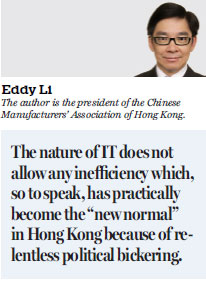A Lok Ma Chau tech park is a feasible idea
Updated: 2017-01-23 06:55
By Eddy Li(HK Edition)
|
|||||||
Eddy Li hopes the innovation and technology park project can go smoothly and without delays due to unnecessary politicization and red tape
On Jan 3, the Hong Kong government signed a memorandum of understanding (MOU) on jointly developing the Lok Ma Chau Loop with Shenzhen government. The authorities are to develop a Hong Kong-Shenzhen Innovation and Technology Park at the captioned venue, ending its 20-year-long vacancy. This 87-hectare piece of land might become the Hong Kong version of Silicon Valley in future.
Among all the political controversies in recent days, what people are asking most about the joint development is: Which side benefits more from it? In accordance with Decree No 221 of the State Council promulgated on July 1 of 1997, after the river training works of the Shenzhen River, the boundary will follow the new center line of the river northward, driving the loop area which was originally within Shenzhen into the administrative boundary of the HKSAR. The historical facts have caused ambiguities over the right of attribution. This is why a "non-profit making principle" is clearly stated in the MOU. It is to ensure the development project will primarily be used for the benefit of the public and no profit will be disbursed to either side of the river.

So it seems like a tie to me. But don't forget that it is also suggested in the MOU that the land ownership belongs to the HKSAR; and "the use and management of the land in the loop (including but not limited to planning, leasing, allocation of leasing revenue, transfer and renewal), as well as the construction, operations, maintenance and management of the project will follow the law and land administration system of the HKSAR". What's more, the proposed Hong Kong-Shenzhen Innovation and Technology Park will be fully funded and owned by the Hong Kong side, creating 40,000 job vacancies and attracting elites of information technology from all over the world to our city. Land for the development of innovation and technology is great for the industry.
Some might worry about the convenience of transportation to the locale, because geographically the loop is nearer to downtown Shenzhen than urban areas in Hong Kong. I suppose this won't be a big problem, because Hong Kong is a compact city with an advanced transportation network. As stated by Under Secretary for Innovation and Technology David Chung Wai-keung, it will be convenient to work there after access and connections are improved. He also added that concerns of this kind appeared when Sha Tin's Science Park first came into being, while the demand for space in the Science Park is actually increasing at present. I genuinely believe that with the experience of managing the Science Park, the newly proposed park will be in good hands with the Hong Kong Science and Technology Parks Corp.
Another concern is the time of construction. The IT industry brings about new changes almost every single day, and startups of this industry emerge and alter their corporate strategies so frequently that high effectiveness becomes the most crucial point when selecting a location. Whereas the group effect of the park is one of the pros for IT startups, the development time of seven years adds to the cons list. The nature of IT does not allow any inefficiency which, so to speak, has practically become the "new normal" in Hong Kong because of relentless political bickering.
In comparison, the Shenzhen side appears to be more active in developing the loop. Shenzhen has, as early as a year ago, planned the reconstruction of the Huanggang Port - the nearest port of entry to the loop. The reconstruction aims at increasing the capacity of the 24-hour port from 50,000 person times to 300,000. The authorities called for bids in January last year, drafted the proposal for planning last March, conducted a feasibility research in June, 2016, and confirmed the contractor who won the bidding in September. The reconstruction is expected to start in late 2018.
As a one-time member of the Town Planning Board, I totally understand the difficulties in reclaiming a wasteland. A lot of work that is time-consuming has to be done, including foundation engineering, water and power supply, drainage systems, and all the other matching facilities needed according to the development planning. But I truly hope the project can go smoothly and without delays due to unnecessary bureaucracy and politicization.
(HK Edition 01/23/2017 page9)